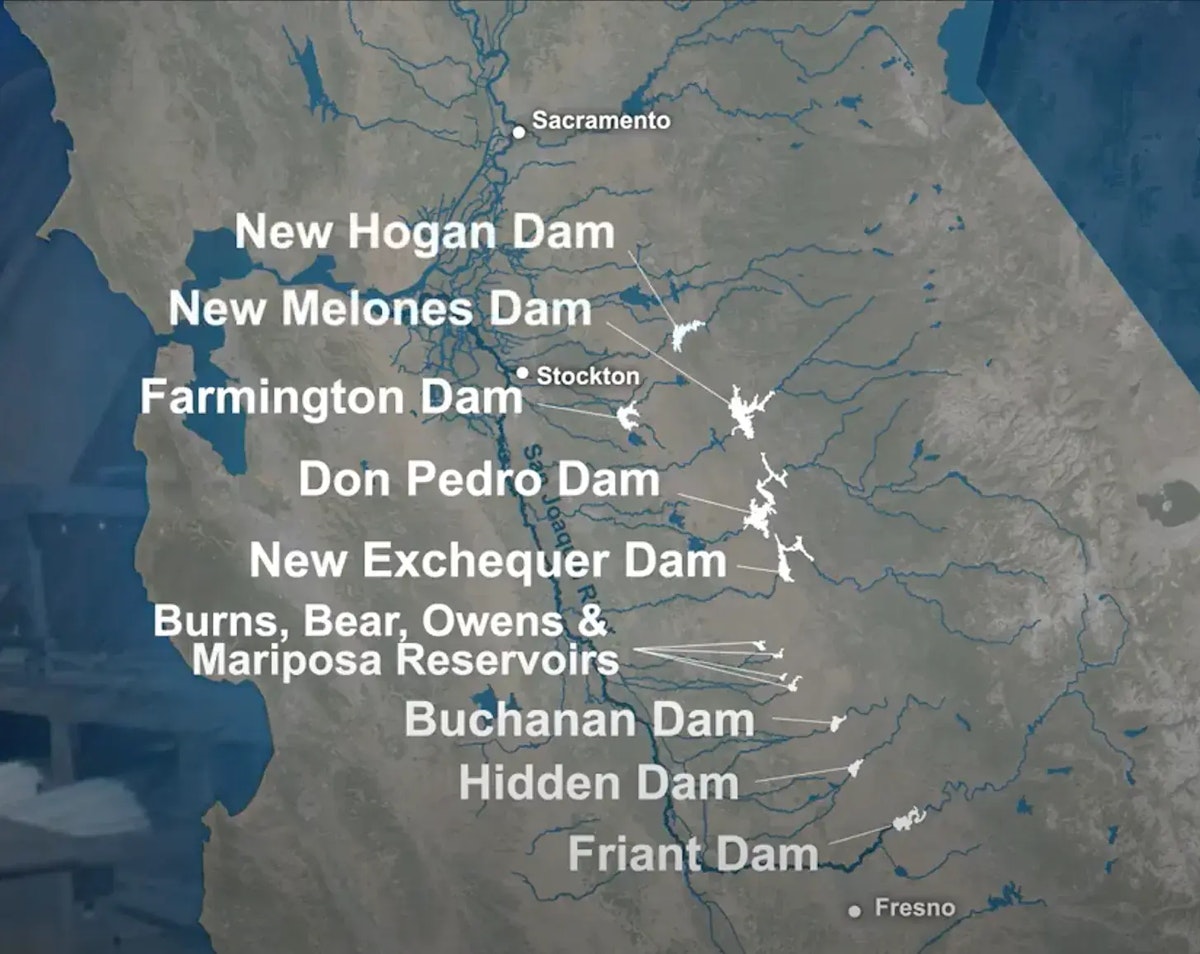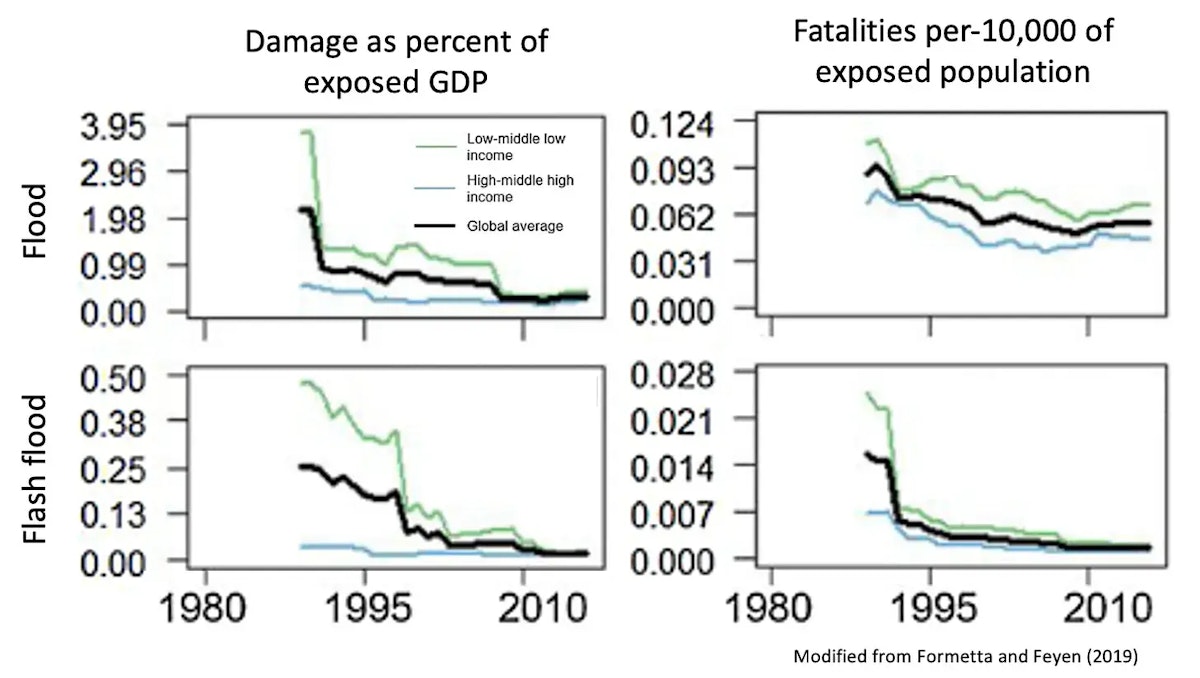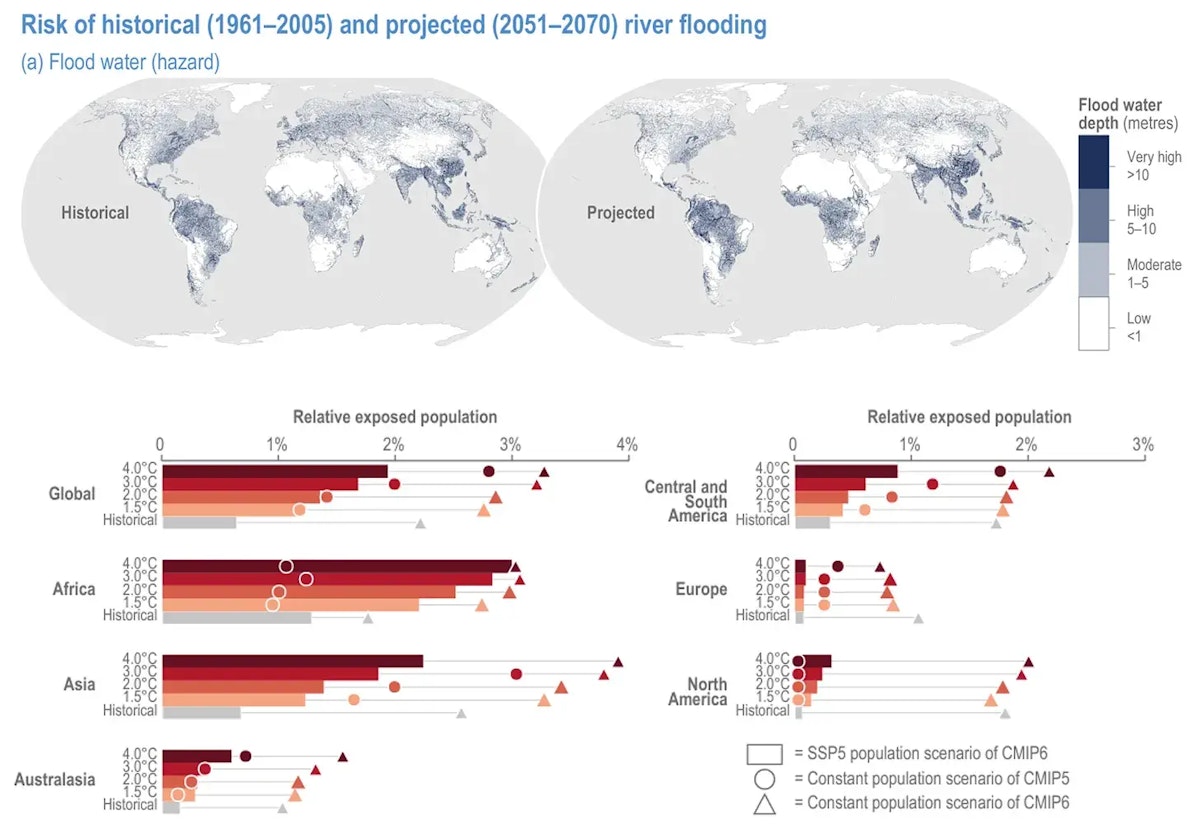Are Floods Dramatically Increasing Due to Climate Change? (Part Two)
On flood exposure and vulnerability
-
-
Share
-
Share via Twitter -
Share via Facebook -
Share via Email
-
Note: This post is part of the collaborative series between The Liberal Patriot and The Breakthrough Institute called “The Climate Report” looking at the science and reporting behind extreme weather events and other climate related matters. This is the second part of a series on flooding and climate. Part one can be read here.
In part one of this series, I looked at how the flood natural hazard—the physical phenomenon of flooding itself—has changed and is expected to change as the climate warms. We saw that matters are complicated and that a global increase in floods is not certain. Nevertheless, the IPCC projects that as warming continues, more locations will see increases in the flood hazard than decreases in it.

But as Dr. Diana Liverman has put it, we need to think about risk not as the probability of the hazard but as the probability of harm. For a flood to become a human disaster, things we care about need to be exposed to the flood and be vulnerable to the flood.
Flood Exposure
Since the mid-1980s, the world population has increased by over 60 percent. We would naturally expect more people to experience flooding because of that fact alone even if floods were not changing at all. This idea can be visualized with the expanding bullseye effect, which shows how the exact same flood (or any hazard) would affect many more people as an urban area grows and the bullseye expands.

In reality, the situation is actually worse than that. The global population has not only expanded but disproportionately expanded into the most flood-prone areas. In fact, the population in flood-prone areas has increased at nearly twice the rate as in less flood-prone areas since the 1980s. To get a good sense of this process, look at these satellite images of changes in Quang Nam, Vietnam, from 2002 to 2021.

The flood plains near the river that were previously unoccupied are now dense urban areas. This is not unique to Quang Nam: the global potential exposure of urban areas to floods increased by more than four times between 1985 and 2018. The figure below breaks down flood exposure by continent, showing that the largest growth in exposure occurred in Asia.

This trend of disproportionate increases in potential exposure is expected to continue into the future. I say “potential exposure” because many of these statistics are calculated by first calculating a flood risk map and then looking at how the population has expanded into flood-prone areas (i.e., how much population is in a predefined 100-year floodplain). In other words, they are looking at potential exposure and not actual or realized exposure to floods.
Regardless, given that changes in the flood hazard itself are not large globally (see part one), fanfare about apparent increases in the reported number of flood disasters will be much more of a reflection of the fact that more people live in the way of floods than it is of climate change causing more or larger floods. But that raises an obvious question: “Have more people actually been exposed to real floods in recent years?” Since the era of good satellite data, it doesn’t appear so.
The plot below from this study shows the satellite-observed flooded area (the flood hazard, in blue) and the population exposed to the flood hazard (red) starting when sufficient satellite coverage begins in the early 2000s.

It appears that over this time period, there is no trend in people experiencing floods despite an increasing number of people living in floodplains. This is a somewhat remarkable finding given the media claims about flooding mentioned in part one: “It’s getting harder and harder to adapt to these changing conditions,” as one climate expert put it. “It’s just everywhere, all the time.”
Over such a short period of time, human exposure to actual floods may show no trend due to pure luck. As time goes on, more people living in flood-prone areas should result in more people being flooded. But there is also the issue of changes in flood vulnerability that affect the risk of flood impacts.
Flood Vulnerability
While our exposure to floods has increased in the long term, our vulnerability to them has decreased. A major component of this is the construction of explicit flood control systems, which include dikes, dams, levees, and urban stormwater drainage systems that allow settlements to deal with inundations of water when they occur.

The San Joaquin River flood management system in California provides a good example.
Extensive flooding is natural and common in California’s Central Valley, and as the region's populations and assets grew, flooding became increasingly intolerable over the 20th century. This led to a system of 12 dams and reservoirs that can substantially absorb excess water when heavy rain and snowmelt occur.

Systems like this are obviously not perfect and are continuously being evaluated and updated, but it is demonstrably the case that they reduce flooding. For example, “regulated” river basins in the United States with substantial reservoir storage have seen marked decreases in annual maximum stream flows over time. This means that when it comes to flooding, we’d rather live in a warmed climate with flood protection than live in a preindustrial climate with preindustrial flood protection.
These systems are common worldwide, and approximately 3 million dams currently regulate about half of the world's river systems. Thanks in part to systems like these, both global flood fatalities as a fraction of those exposed to floods and flood damages as a fraction of GDP exposed to floods have decreased since the 1980s.

This progression is associated with economic growth, and if you look across societies today, you’ll see that wealthier is better: Flood fatalities as a fraction of those exposed to floods and flood damages as a fraction of GDP exposed to floods are smaller for societies with higher GDPs.
Worldwide, the lethality of river floods decreased 84 percent from 412 deaths per flood in the 1950s to 67 deaths per flood in the 2010s. High-income countries started from a smaller baseline of 86 deaths per event (floods AND storms in this case) in the 1990s but have still progressed to only 16 deaths per event in the decade from 2012-2022—a decrease of 81 percent.
Future Projections
Despite changes in flood exposure (more people being exposed to the flood hazard over time) and flood vulnerability (societies being less sensitive to floods over time) being so important, future projections of flooding often neglect these factors. This is in part due to the fact that it’s simply much more difficult to project changes in technological and socioeconomic factors than it is to project changes in the physical climate system. However, the neglect of these two dominant factors means that a lot of projections that focus exclusively on the physical hazard are of very limited practical use.
Below are the IPCC’s projections of river flooding and the fraction of the population exposed to flooding. Globally you see a 0.7 percent annual exposure to floods historically increase to 1.7 percent under 3°C of warming (bars).

However, IPCC reports calculated exposure for when the magnitude of a simulated flood “exceeds current flood protection,” effectively ignoring the changes in vulnerability that have been so important historically or assuming that no further changes occur. This is somewhat absurd when you consider that 3°C of warming is associated with several-fold increases in global GDP and ~50 percent to ~300 percent increases in total societal energy use. To take these projections seriously, you’d have to imagine that none of that extra wealth and energy use goes towards flood control.
Research that has attempted to take future changes in flood control systems into account paints a more optimistic picture and has suggested that despite increasing population and value in flood-prone areas, the widespread adoption of flood control infrastructure could result in decreases in the absolute number of fatalities and economic losses from floods, even under the worst case climate change scenarios.

Overemphasis of the flood hazard
For a flood to be a natural disaster, it requires not only the flood hazard itself but also, exposure (people living in the way of the flood), and vulnerability (inability to deal with the flood). Overall, there is very solid evidence that one component of the flood hazard—extreme precipitation—has been and will continue to increase in most locations as it warms. However, there are offsetting factors (such as reduced water in the soil and reduced snowpack as it warms) that make it absolutely plausible that the global inland flood hazard could remain roughly steady over time.
Even though there is not a strong coherent global increase in the inland flood hazard, media coverage tends to focus narrowly on the single part of the problem (extreme precipitation) that can be most directly connected to increased greenhouse gasses. This is counterproductive because it leaves the impression that the most effective way to deal with flood disasters is through emissions reductions when in reality, changes in exposure and vulnerability play a much larger role in driving changes in flood disasters, and we can influence exposure and vulnerability much more directly in the near term than we can the physical flood hazard.

